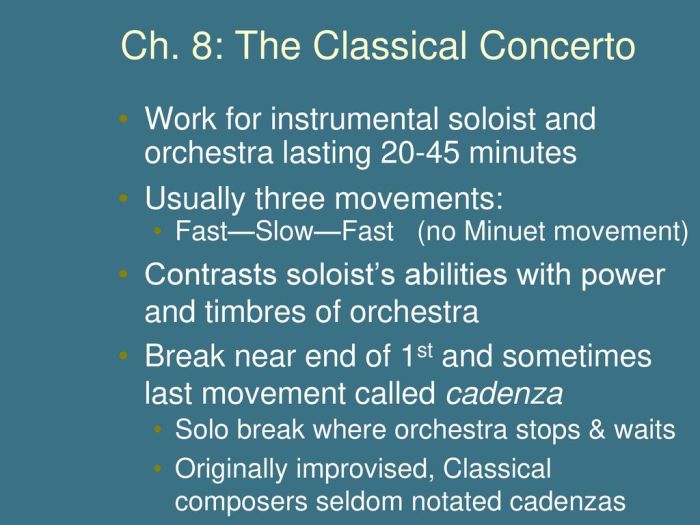What statement best describes a cadenza? A cadenza is an improvised or written-out solo passage for a soloist, typically occurring towards the end of a movement in a concerto or other large-scale musical work. Cadenzas allow the performer to showcase their technical virtuosity and interpretative skills.
Cadenzas have a rich history, evolving from simple embellishments to complex and elaborate displays of musical prowess. They can vary greatly in length and style, from short, improvisatory flourishes to extended, composed sections that can rival the length of the movement itself.
Definition of Cadenza

A cadenza is an improvised or written-out solo passage for a soloist in a concerto or other musical work. It is typically performed at the end of a movement and allows the soloist to display their virtuosity and creativity.
Cadenza has a long history, dating back to the Baroque period when it was used as an improvisatory section. In the Classical period, cadenzas became more structured and were often written out by the composer.
Characteristics of a Cadenza

Cadenza typically has a three-part structure:
- Entry: A short, melodic phrase that introduces the cadenza.
- Development: A section of virtuosic passagework that explores the themes of the movement.
- Coda: A concluding section that brings the cadenza to a close.
Cadenza often showcases the soloist’s technical skills and their ability to improvise.
Types of Cadenza
There are several types of cadenzas, including:
- Written cadenzas: These are written out by the composer and are typically found in classical concertos.
- Improvised cadenzas: These are improvised by the soloist during the performance.
- Ornamented cadenzas: These are written cadenzas that include improvisatory elements.
Some famous cadenzas include the cadenza in Beethoven’s Violin Concerto and the cadenza in Mozart’s Piano Concerto No. 21.
Cadenza in Various Musical Genres

Cadenza is used in various musical genres, including:
- Classical music: Cadenza is a common feature of classical concertos.
- Jazz music: Cadenza is used in jazz solos to allow the soloist to improvise and explore the themes of the piece.
- Contemporary music: Cadenza is used in contemporary music to create a sense of freedom and spontaneity.
Historical Significance of Cadenza
Cadenza has played an important role in the development of music. It has allowed soloists to display their virtuosity and has helped to create a sense of excitement and spontaneity in musical performances.
Some of the most famous composers, including Mozart, Beethoven, and Brahms, have written cadenzas for their own concertos.
Modern Interpretations of Cadenza: What Statement Best Describes A Cadenza

In recent years, there has been a growing trend towards more experimental and innovative cadenzas. Some composers are incorporating elements of jazz and other musical genres into their cadenzas.
Other composers are using cadenzas to explore new sounds and textures. For example, the composer John Adams has written a cadenza for the violin that uses extended techniques such as harmonics and pizzicato.
FAQ Corner
What is the purpose of a cadenza?
A cadenza provides a soloist with an opportunity to showcase their technical virtuosity and interpretative skills.
Are cadenzas always improvised?
No, cadenzas can be either improvised or written out by the composer.
Where are cadenzas typically found?
Cadenzas are typically found towards the end of a movement in a concerto or other large-scale musical work.
